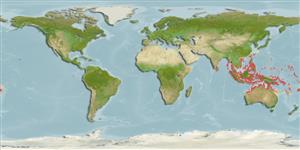Environment: milieu / climate zone / depth range / distribution range
Ecologie
marien; brak water rifbewoner; diepte 0 - 20 m (Ref. 48637), usually 0 - 15 m (Ref. 90102). Tropical; 19°C - 38°C (Ref. 1827); 30°N - 30°S, 77°E - 20°W
Indo-West Pacific: India, Sri Lanka, Andaman Islands, Thailand, Malaysia, Singapore, Indonesia, Philippines, Belau [=Palau], Guam, New Guinea, Solomon Islands, Fiji, Vanuatu, ?New Caledonia, ?Western Australia, ?Pohnpei, Caroline Islands, ?Ebon Island and Marshall Islands.
Grootte / Gewicht / Leeftijd
Maturity: Lm ? range ? - ? cm
Max length : 45.0 cm TL mannelijk / geslacht onbekend; (Ref. 1419); common length : 30.0 cm TL mannelijk / geslacht onbekend; (Ref. 9813); max. gepubliceerd gewicht: 2.4 kg (Ref. 125599)
Dorsale stekels (totaal): 13; Dorsale zachte stralen (totaal): 10; Anale stekels 7; Anale zachte stralen: 9; Wervels: 13. Body bluish white; head brown to brownish or golden yellow with irregular blue lines. Preopercular angle 91°-102°; strong overlapping scales cover cheeks; midline of thorax scaled, not pelvic ridges. Anterior nostril with low flange, broadened slightly posteriorly. Spines stout, blunt or pungent, and venomous.
Juveniles live among mangroves then move out to lagoon and coastal reefs as they mature. Forms schools. Feeds on algae growing on seagrasses, mangrove roots and rocks. Adults congregate inshore in groups of several hundreds to spawn in summer. Spawning is by pairs; sticky eggs laid on the bottom. Its very high quality flesh commands premium prices (Ref. 9813). Adults on coastal reefs, subject to strong currents (Ref. 48637). This species can tolerate very low salinities (2 ppt) and temperatures up to 38 C (Ref. 37816).
Throughout summer, adults form inshore breeding groups of several hundred individuals on the 7th or 8th days of the lunar month; pairs break from these groups to spawn. The species has a high fecundity of 350,000/spawning season.
Woodland, D.J., 1990. Revision of the fish family Siganidae with descriptions of two new species and comments on distribution and biology. Indo-Pac. Fish. (19):136 p. (Ref. 1419)
Status op de Rode Lijst van het IUCN (Ref. 130435)
Gebruik door de mens
Visserij: commercieel; Aquacultuur: mogelijk toekomstig gebruik; Aquarium: Commercieel
Meer informatie
ReferentiesAquacultuurAquacultuurprofielKweeklijnenGeneticaElectrophoresesErfelijkheidZiektesVerwerkingNutrientsMassaconversie
Tools
Speciale rapporten
Download XML
Internetbronnen
Estimates based on models
Preferred temperature (Ref.
123201): 26.2 - 29.3, mean 28.6 °C (based on 2941 cells).
Fylogenetische diversiteitsindex (Ref.
82804): PD
50 = 0.5000 [Uniqueness, from 0.5 = low to 2.0 = high].
Bayesian length-weight: a=0.01230 (0.00669 - 0.02263), b=3.13 (2.97 - 3.29), in cm total length, based on LWR estimates for this species & Genus-body shape (Ref.
93245).
Trofisch niveau (Ref.
69278): 2.0 ±0.00 se; based on food items.
Weerstandsvermogen (Ref.
120179): Gemiddeld, minimale populatieverdubbelingstijd 1,4-4,4 jaar (K=0.3).
Fishing Vulnerability (Ref.
59153): Low vulnerability (20 of 100).
Nutrients (Ref.
124155): Calcium = 44.8 [22.4, 129.2] mg/100g; Iron = 0.979 [0.445, 2.429] mg/100g; Protein = 19 [17, 21] %; Omega3 = 0.0994 [, ] g/100g; Selenium = 35.2 [11.4, 95.8] μg/100g; VitaminA = 10.3 [2.0, 55.5] μg/100g; Zinc = 1.82 [0.68, 4.15] mg/100g (wet weight);
